 |
This chapter will tell you how to make torsion springs. Before you start, read the section on The Setup, and have your setup done (spring coil diameter correct).
Don't forget that torsion springs come left-handed and right-handed. Be sure to make your setup for the correct hand. If you're making a left-handed spring, remember that the setup and the motion of the chuck and arbor will be OPPOSITE to what is described.
 |
When you're ready to start coiling, the first thing you need to do is figure out how much wire you'll need to make your spring. Here's how:
Now you're ready to actually start.
Your setup should now look like this (these diagrams will show both a hand-held wire guide and a tool post-mounted wire guide):
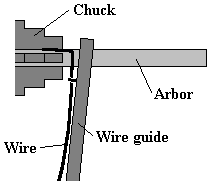
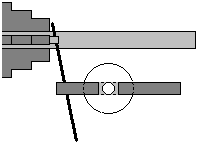
READ THE NEXT STEP ALL THE WAY THROUGH BEFORE YOU START IT.
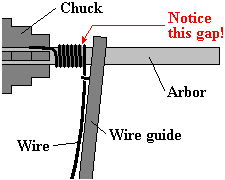
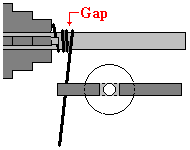
| The process of baing out the stress in the wire may change the dimensions of your spring. Stainless steel coils will generally expand slightly when heated: music wire coils will generally contract slightly. |
When you've finished this process, let the spring air-dry and measure it to see how close you came to what you want. Check the diameter first. If it's not OK, don't bother going any further: you'll need a different arbor, which will change all the rest of your dimensions.
If the diameter is OK, count the number of coils in your spring. You should be pretty close: if you're only making one or two springs, being an eighth of a coil off either way is OK -- you can always strip out or add a small amount of coil by hand. If you're more than an eighth of a coil off, figure out how much more or less you need and change the chalk mark on your chuck so that the next time you wind a spring, you can stop coiling at the right spot.
Lastly, look at the coils themselves. They should all lie flat against each other, all the way out to the ends of the spring body. If you see gaps in the body of the spring, that means that you let the wire guide go too far to the right while you were coiling. If you see a gap at one end (usually the "front" end), that means that when you started coiling, your wire guide was too far to the right of the pickup pin.
Finally, set this spring aside to use in setting up for bending the legs. If needed, repeat the coiling process again until you get what you want. At this point, you're ready to begin work on the ends.
When you coil your springs, it's a good idea to wind up a few
extras so you can practice making whatever bends you need to the
legs. When you have one spring that's exactly what you want, bends
and all, stress relieve it again, doublecheck all your measurements,
and, if possible, test it where it'll be used. Then, make all the
bends in as many springs as you need.
Take the extra springs to
figure out how best to form the ends the way you want them. There
are a million different ways to form the ends of torsion springs, so
what this section will tell you is general principles to follow.
Start with straight ends. If you're using light wire, the curve of the coil will probably make the ends of your springs curved. The curve is called "cast". You can straighten it out by running the wire over your thumbnail or by bending the wire in the direction opposite to the cast by hand.
Heavy wire usually doesn't have this problem, unless it's stainless steel. To straighten heavy wire, secure the spring in a vise and use a pipe for leverage, straightening the wire by hand a little at a time.
Make your bends gradual. This is the difference between a gradual bend and a sharp bend:

A sharp bend may cause the wire to break when a load is placed on the spring. As you figure out how to form your ends, keep this in mind. The best tool to use for light wire is round-nose pliers.
Always relieve the stress in your springs again after you form the ends. A second stress relief won't likely change any dimensions, but it will allow the bends in the formed ends to stay in the shape you put them in when they're under load.
Here's a quick way to make torsion spring ends. It's not too precise, but then again, maybe your spring doesn't have to be, either.
Find a rod that you can use to make the bend. Try not to have it skinnier than twice the diameter of your wire.
Mount the rod in your vise, along with a pickup pin. Put the end of the spring between the pickup pin and the rod. Measure the distance so that when you're done, it comes out right.
Using a wire guide or a bending pipe, bend the end the way you want it. (With very light wire, you can do this by hand.) If the spring slips as you bend the end around, put some pressure on the coil body so that the pickup pin grabs it solidly.
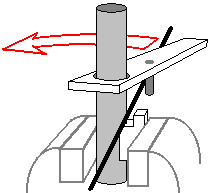
If you're just making a few springs, you can probably get away with doing each one by hand.
If you want to make a lot of the same kind of spring, go ahead and make a more sophisticated bending jig -- see the section on tooling for how to do this.
If you're making an extension spring with extended hooks, like this:
you'll need to treat the ends as if the spring was a torsion spring.
The first step in forming extended hooks is to make sure that the ends of the wire are straight. Having done that, the next step is to lay the ends over. Here's how you do this:

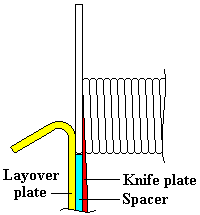
To fix these errors, A) raise or B) lower the spacer plate.
This procedure will give you ends that come straight off the ends of the coil, and fom here you should be able to form hooks or loops, as you wish.
Forward to how spring shops work.